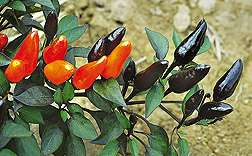Ornamentals to Brighten the Fall Garden Palette

(ĖĮÐÄĘÓÆĩOrg.com) -- With âtrick-or-treatersâ coming soon, imagine two spirited new pepper varieties making an appearance in your neighborhood as well. The new pepper cultivars have been released by the Agricultural Research Service (ARS) and are trademarked âLilâ Pumpkinâ and âPepper Jack.â
These plants are scheduled to become available in time to add seasonal interest to next yearâs fall gardens during the Halloween and Thanksgiving holidays.
The peppers were bred by ARS plant geneticists John Stommel and Robert Griesbach, both at the Henry A. Wallace Beltsville Agricultural Research Center (BARC) in Beltsville, Md. Stommel works in the ARS Genetic Improvement of Fruits and Vegetables Laboratory, and Griesbach is a former researcher with the ARS Floral and Nursery Plants Research Unit.
Lilâ Pumpkin has unique black foliage and orange pumpkin-like fruit. Pepper Jack bears greenish-black foliage and a mix of orange and black, small, cone-shaped fruit, similar to the ever-popular Halloween candy corn.
The breeders developed Lilâ Pumpkin and Pepper Jack with both ornamental and culinary markets in mind. The peppersâ vibrant colors and unique shapes provide enticing ornamental interest, and their spicy flavor may be of culinary interest to hot-pepper lovers.
Lilâ Pumpkin and Pepper Jack join a long list of popular ornamental vegetables that includes kales, lettuces, sweet potatoes and eggplants, as well as culinary counterparts such as multicolored Swiss chard, orange watermelons, purple snap beans and purple asparagus.
The new ornamental garden vegetables can be grown as bedding plants and in containers, and they will be marketed in pots as annuals. Similar to culinary peppers, ornamental peppers perform best in high light and warm temperatures, according to the breeders.
Lilâ Pumpkin and Pepper Jack have been licensed for retail sale by McCorkle Nurseries, Inc., in Dearing, Ga. They are scheduled to become available in various garden centers and retail stores nationwide in 2010.
Provided by USDA Agricultural Research Service



















